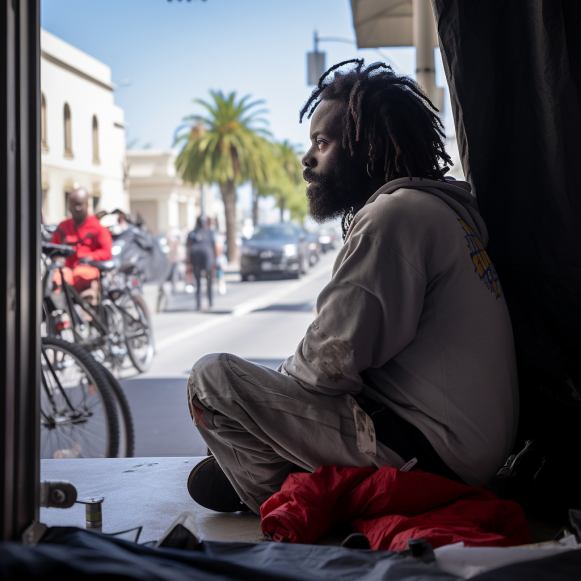‘It’s either this place or a tent in a field’: San Jose evicts homeless squatters from city-owned house

The eviction points to the struggle to house the city’s 9,900 homeless residents
Orrin Carr peered through dark lace curtains from inside the lone house at the end of an orchard-lined street on San Jose’s Northside, expecting authorities to arrive at any moment. He’d taken a hot shower that morning, certain it was his last for a while.
A fleet of white trucks, animal control vehicles, and a police cruiser soon arrived. Carr and the other half-dozen homeless people who had been squatting on the city-owned property for months were given a few hours to pack their belongings. Public works crews began sawing plywood sheets to board up the seven-bedroom, single-story building, which is shaded by tall palm trees and surrounded by a garden of shrubby pink rose bushes.
Squatters were promised spaces in tiny homes by outreach teams. However, some people, including Carr, turned down the shelters because they were unsure whether the nonprofit workers would follow through on their offer and were concerned about having to part with their belongings.
“Maybe I could find another empty house,” Carr speculated. “I’m constantly scouting them. In San Jose, there are numerous vacant houses.”
It’s unclear how many vacant properties are being used by squatters in San Jose and throughout the Bay Area. Such records are not kept by officials. In recent years, however, some homeless residents have made headlines by moving into vacant homes, such as when Moms 4 Housing, a collective of then-homeless women, took over a privately owned house in West Oakland in 2019 to protest investor-backed companies buying up homes in the East Bay.
To protest the city’s lack of affordable housing, homeless families moved into a handful of vacant houses owned by Caltrans the following year in Los Angeles.
Nonetheless, squatting in city or state-owned homes appears to be uncommon. And the situation in San Jose had nothing to do with activism. However, Thursday’s forced eviction at 1157 East Taylor St. was an unmistakable result of the city’s ongoing struggle to house its estimated 9,900 homeless residents as it faces a chronic affordability crisis.
City officials claimed they previously offered shelter to those living on the property but were turned down, which Carr denied. According to officials, two of the six people who were living on the property last week eventually accepted shelter. They refused to say how long they had been aware of people squatting on the property. Officials also refused to reveal how many residential properties the city owns.
The city has not revealed its plans for the property now that the squatters have left. According to a report presented to the City Council in April, the city received a proposal from the YWCA earlier this year asking for $350,000 to rehab the site and use it as a child care center.
The city agreed to buy the house for $2.1 million in 2011 because officials thought they needed the land for a future highway project on Highway 101, which borders the property.
Meanwhile, according to city documents, San Jose officials agreed to lease the property back to its former owner, Dr. John Licking, a Sunnyvale dentist, for $1 per month. According to news site San Jose Inside, Licking opened a rehab facility at the site, but it lost its operating license in 2014 after allegations surfaced that its staff had encouraged drug use at the house. Licking denied many of the allegations in an interview with that publication. According to the news report, the facility continued to operate as an unregulated sober living home.
Tiffany Franko, who had been in charge of the home, told this news organization that the facility abruptly closed down last fall because it became too difficult to operate.
Carr, who had previously lived at the facility after serving four decades in prison, returned shortly after learning that Franko was leaving the site.
Carr said he fixed the plumbing and turned on the utilities, including creating a fake lease to pay the water bill, and invited other homeless people to stay in the house. Another two or three people had moved into wooden chicken coops with palm-tree-frond-covered roofs on the property outside the house. The front yard was populated by a brown and white pit bull mix.
“We were just thinking, well, we’ll just pay our bills and enjoy living here because it’s a great place to live,” Carr said just before the eviction, sitting in his bedroom, which was decorated with multicolored mandala blankets and a cinder block shelf holding cans of Hormel Chili and Campbell’s tomato soup. “This is a fantastic neighborhood. Is there no neighbors or nothing?”
When other homeless people found out about the squatters, they began breaking in and threatening to take over the property, according to Carr. Every night, he slept with a can of mace and a sheathed knife next to his bed.
This summer, things improved after the city removed encampments from nearby Coyote Creek. But Carr realized he’d be forced out soon, so he turned to a nonprofit for assistance in finding a permanent home, he said.
“Until then, it’s either this place or a tent in a field,” Carr said a few days before renting two moving trucks to pack up the house with another squatter. “And this is a lot better than a tent in the middle of a field.”




